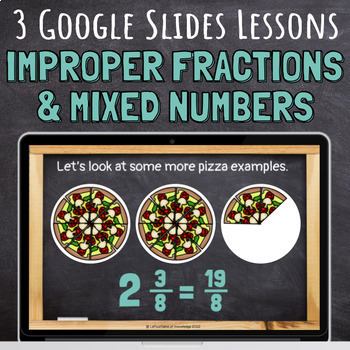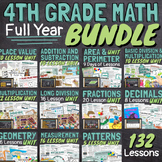Improper Fractions and Mixed Numbers 3 Google Slides Lessons with Practice
- Google Slides™

What educators are saying
Also included in
- This bundle of 13 Google Slides fraction lessons reviews basic 3rd grade fraction concepts to build conceptual understanding and extends to cover all 4th grade CCSS fractions standards. Skills/concepts includes: an introduction to fractions - what is a fraction?, how to write a fraction using a numePrice $23.80Original Price $34.00Save $10.20
- This bundle of Google Slides math lessons is perfect for introducing 4th grade level math concepts to your students. Each lesson is aligned to Common Core State Standards (CCSS) and jammed packed with engaging visuals that help students build conceptual understanding. Through simple explanations andPrice $108.63Original Price $217.25Save $108.62
- This 4th grade fractions math unit includes 20 easy to teach lessons that reinforce and review 3rd grade standards (CCSS) and introduce fourth grade standards (common core aligned). Skills taught include: identifying and naming fractionsdrawing fractions using pie models and bar modelsidentifying anPrice $37.50Original Price $62.50Save $25.00
- This year long fourth grade math bundle includes 132 math lessons spanning 11 different units. All lessons are common core aligned and cover all CCSS standards required for 4th grade math!Begin with each unit guide (these are free and linked below!). The lesson plans will walk you through each unitPrice $156.80Original Price $392.00Save $235.20
Description
These Google Slides lessons explore writing fractions that are greater than one whole as both mixed numbers and improper fractions. The lessons use concrete modeling to help build conceptual understanding of improper fractions and mixed numbers. They also introduce algorithms for changing from improper to mixed and mixed to improper.
Lesson 1: What are improper fractions and mixed numbers?
- uses pizza visuals to build conceptual understanding of fractions and explain what mixed numbers and improper fractions are
- shows how to use a mixed numbers and improper fractions to represent an amount of pizza and demonstrates how the same amount of pizza could be represented using equivalent mixed numbers and improper fractions
- provides 6 independent practice problems (just click to reveal the answers) with access to a FREE printable worksheet.
Lesson 2: Changing improper fractions to mixed numbers
- explains why we might need to do this
- uses a visual fraction model to change an improper fraction to a mixed number
- shows how to use division as a shortcut to change an improper fraction to a mixed number (with several examples)
- provides 6 independent practice problems (just click to reveal the answers) with access to a FREE printable worksheet.
Lesson 3: Changing mixed numbers to improper fractions
- explains why we might need to do this
- uses a visual fraction model to change a mixed number to an improper fraction
- shows how to use multiplication and addition as a shortcut to change a mixed number to an improper fraction (with several examples)
- provides 6 independent practice problems (just click to reveal the answers) with access to a FREE printable worksheet.
These slides are fully editable if you need to tweak them to better fit your needs. Be sure to check the preview file for a closer look at this lesson (note, the Google Slides feature animations that will not work in the PDF preview file, but it still gives you a good idea of what the lesson includes!)
For an interactive Google Classroom assignment with practice problems that accompanies these slides, click here!
Please follow my store here for more great resources!
You can also find me on Facebook, Instagram, and lafountaineofknowledge.com where you'll discover ideas, inspiration, and plenty of freebies! Or join my email list to get my monthly newsletter with exclusive FREE resources you can't get anywhere else!
Want free money to spend on Teachers Pay Teachers? Rate this product to earn some TpT credit! Leaving feedback helps us both out and takes less than a minute! Your support makes it possible for me to continue making and sharing great resources! Thank you!
Credits: Clip art by The Cher Room, used with permission. The background was sourced via Pixabay and was used with permission. Fonts used include Londrina Solid and Londrina Shadow by Marcelo Magalhães, Pangolin by Kevin Burke, and Amatic SC by Vernon Adams. All fonts were used with permission under open source licenses.









